Plovoucí sál / Floating stage

Project idea
EN/ The task of the design was to design a floating hall for concerts falling under the category of Fine Arts with a capacity of approximately 500 people.
The design concept was based on the location of the site and the function of the building. The building takes the form of a lime leaf that has fallen to the surface of the water from Slovanský ostrov. The lime tree is a national tree, so its leaf becomes a symbolic addition to the National Theatre.
CZ/ Zadáním návrhu bylo navrhnout plovoucí sál sloužící pro konání koncertů spadajících do kategorie Fine Arts s kapacitou přibližně 500 osob.
Koncept návrhu vycházel z lokality místa a funkce stavby. Stavba má podobu lipového listu, který spadl na hladinu vody ze Slovanského ostrova. Lípa je národním stromem, její list se tak stává symbolickým doplněním Národního divadla.
Project description
EN/ According to the specifications, the hall should be variable and transportable to the port in case of floods. The dimensional limitations were based on this fact, with the maximum size of the pontoon set at 54.5 x 10.6 x 4.5 m (lxwxh) with a maximum draft of 1.2 m for an empty building.
These constraints were the limiting design constraints.
The floating hall was designed as a multifunctional hall. During the day, the hall can be used for a variety of activities from lectures to performances to sporting events or the organisation of fairs or small markets.
The stage area is designed in a tiered manner so that the different levels can be used for seating as well as for the other activities mentioned above.
If necessary, the auditorium can be equipped with 420 seats, increasing the capacity to 480 seats.
The floating auditorium building is connected to the technical tunnel of the National Theatre, where there is a foyer with seating, toilets and storage for seats and equipment. Facilities for performers are planned directly in the National Theatre.
Access to the hall itself for visitors is directly from the embankment in the form of steps that follow the pier leading to the leaf.
CZ/ Sál by dle zadání měl být variabilní a v případě povodní přepravitelný do povodňového přístavu. Z této skutečnosti vycházely rozměrové omezení, kdy byl stanoven maximální rozměr pontonu na 54,5 x 10,6 x 4,5 m (dxšxv) s maximálním ponorem prázdného objektu 1,2 m.
Tyto restrikce byly omezujícími limity návrhu.
Plovoucí sál byl navržen jako sál multifunkční. Přes den může sál sloužit pro různé činnosti od přednášek přes vystoupení až po sportovní akce nebo pořádání jarmarků či malých trhů.
Plocha jeviště je navržena stupňovitě tak, aby jednotlivé výškové stupně mohly být využity pro sezení, ale i pro zmiňované jiné aktivity.
V případě potřeby lze hlediště vybavit 420 sedadly a navýšit tak kapacitu na 480 míst pro sezení.
Objekt plovoucího sálu je napojen na technický tunel Národního divadla, kde najdeme foyer s posezením, toalety a sklady pro sedadla a vybavení. Zázemí pro účinkující je uvažováno přímo v prostorách Národního divadla.
Přístup do sálu samotného je pro návštěvníky veden přímo z nábřeží v podobě schodů, které navazují molo vedoucí k listu.
Technical information
EN/ The floating hall consists of three pontoons that are anchored via a "truss" to a circular extension of the pier. This extension forms a hinge around which the whole hall can oscillate or rotate to a certain extent according to the changing direction of the river. This hinge also allows the canopy to be opened by hydraulic pistons.
By this opening it is possible to achieve an open-air concert or performance.
The structure of the canopy consists of a tubular structure sheathed with a membrane of a slightly transparent white colour. The membrane is illuminated by RGB LED lights with diffusers to achieve the effect of the changing colour of the leaf throughout the year.
The structure is symmetrical and divisible into parts that can be transported in case of flooding.
The steel structures of the footbridges and pontoons are covered with wood.
CZ/ Plovoucí sál se skládá ze tří pontonů, které jsou ukotveny přes „řapík” do kruhového rozšíření mola. Toto rozšíření tvoří kloub, kolem kterého celý objekt sálu může v určitém rozsahu kmitat či rotovat dle měnící se ho směru proudu řeky. Tento kloub také umožňuje rozevření zastřešení pomocí hydraulických pístů.
Tímto rozevřením je možno docílit koncertu či představení pod širým nebem.
Konstrukce zastřešení je tvořena trubkovou konstrukcí opláštěnou membránou lehce transparentní bílé barvy. Membrána je osvětlena RGB LED svítidly s difuzéry k dosažení efektu v průběhu roku měnící se ho zbarvení listu.
Konstrukce je symetrická a rozdělitelná na části, které lze přepravit v případě povodní.
Ocelové konstrukce lávek a pontonů jsou opláštěny dřevem.



